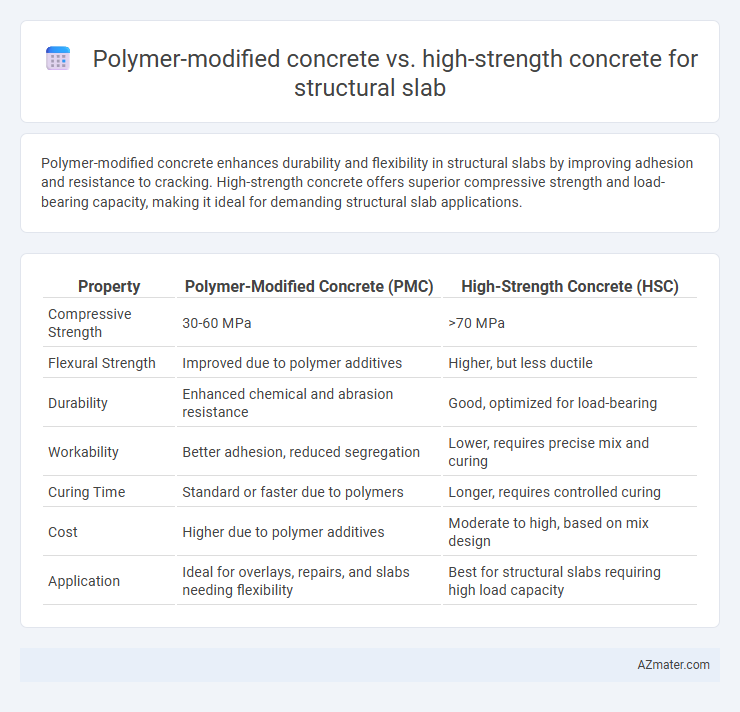Polymer-modified concrete enhances durability and flexibility in structural slabs by improving adhesion and resistance to cracking. High-strength concrete offers superior compressive strength and load-bearing capacity, making it ideal for demanding structural slab applications.
Table of Comparison
| Property | Polymer-Modified Concrete (PMC) | High-Strength Concrete (HSC) |
|---|---|---|
| Compressive Strength | 30-60 MPa | >70 MPa |
| Flexural Strength | Improved due to polymer additives | Higher, but less ductile |
| Durability | Enhanced chemical and abrasion resistance | Good, optimized for load-bearing |
| Workability | Better adhesion, reduced segregation | Lower, requires precise mix and curing |
| Curing Time | Standard or faster due to polymers | Longer, requires controlled curing |
| Cost | Higher due to polymer additives | Moderate to high, based on mix design |
| Application | Ideal for overlays, repairs, and slabs needing flexibility | Best for structural slabs requiring high load capacity |
Introduction to Modern Concrete Technologies
Polymer-modified concrete enhances durability and flexibility by incorporating synthetic polymers, making it ideal for structural slabs exposed to dynamic loads and harsh environments. High-strength concrete achieves superior compressive strength, exceeding 6000 psi, suitable for slabs requiring high load-bearing capacity and reduced thickness. Modern concrete technologies leverage these innovations to optimize structural performance, longevity, and resilience in construction applications.
Defining Polymer-Modified Concrete
Polymer-modified concrete (PMC) enhances traditional concrete by incorporating polymer resins, improving adhesion, flexibility, and durability, making it ideal for structural slabs exposed to harsh environments. High-strength concrete (HSC) focuses on increased compressive strength through lower water-cement ratios and advanced admixtures, delivering superior load-bearing capacity but often less flexibility than PMC. The polymer integration in PMC results in reduced permeability and improved resistance to chemical attacks and cracking, essential for long-lasting structural slab performance.
Understanding High-Strength Concrete
High-strength concrete (HSC) offers compressive strengths typically above 6000 psi, providing superior load-bearing capacity and durability for structural slabs compared to polymer-modified concrete. The dense microstructure of HSC reduces permeability, enhancing resistance to environmental factors such as freeze-thaw cycles and chemical attacks. Its optimized mix design, often incorporating silica fume or fly ash, ensures improved mechanical properties and long-term performance critical for high-stress applications in infrastructure.
Composition and Material Properties Comparison
Polymer-modified concrete incorporates polymers such as styrene-butadiene or acrylics, enhancing adhesion, flexibility, and resistance to chemical attack, which improves durability and tensile strength in structural slabs. High-strength concrete relies on low water-cement ratios and high cement content combined with supplementary cementitious materials like silica fume or fly ash, resulting in compressive strengths typically above 6000 psi and increased stiffness. While polymer-modified concrete offers improved toughness and crack resistance, high-strength concrete provides superior load-bearing capacity and reduced permeability, making each suitable for different structural slab performance requirements.
Performance Under Load: Strength and Durability
Polymer-modified concrete enhances bond strength and flexibility, improving crack resistance and durability under load in structural slabs. High-strength concrete offers superior compressive strength and stiffness, enabling it to carry higher loads with less deformation. Durability in polymer-modified concrete excels in aggressive environments, while high-strength concrete provides long-term structural stability with reduced permeability.
Workability and Construction Considerations
Polymer-modified concrete enhances workability through improved adhesion and flexibility, allowing easier placement and reduced risk of cracking in structural slabs. High-strength concrete offers superior compressive strength but often requires meticulous mixing and curing processes to maintain workability and prevent brittleness. Construction considerations favor polymer-modified concrete for projects demanding durability and resilience, while high-strength concrete suits applications prioritizing load-bearing capacity with careful handling protocols.
Resistance to Environmental Factors
Polymer-modified concrete exhibits superior resistance to environmental factors such as chemical attack, freeze-thaw cycles, and chloride ion penetration due to the incorporation of polymers that enhance durability and reduce permeability. High-strength concrete offers excellent compressive strength but may be more susceptible to microcracking and moisture ingress under aggressive conditions unless supplemented with additional protective measures. For structural slabs exposed to harsh environments, polymer-modified concrete provides enhanced longevity and performance by mitigating deterioration mechanisms caused by environmental stressors.
Cost Analysis and Economic Feasibility
Polymer-modified concrete (PMC) typically incurs higher material costs due to the addition of polymers, but offers improved durability and reduced maintenance expenses for structural slabs, leading to long-term economic benefits. High-strength concrete (HSC) requires higher cement content and specialized admixtures, increasing initial costs, yet can achieve slimmer slab profiles, reducing formwork and reinforcement expenses. Economic feasibility depends on project-specific factors such as slab design, expected load, and lifespan, where PMC suits applications prioritizing durability while HSC benefits projects needing high load capacity and structural efficiency.
Sustainability and Environmental Impact
Polymer-modified concrete enhances durability and reduces permeability, leading to longer service life and less frequent repairs, which minimizes resource consumption and environmental footprint over time. High-strength concrete offers reduced material volume due to its superior load-bearing capacity, decreasing the demand for cement and aggregates, thereby lowering CO2 emissions associated with production. Both materials contribute to sustainable structural slabs by optimizing lifespan and reducing the embodied energy, but polymer-modified concrete particularly excels in minimizing maintenance-related environmental impacts.
Best Applications for Structural Slabs
Polymer-modified concrete enhances durability and chemical resistance, making it ideal for industrial floors and environments exposed to harsh chemicals. High-strength concrete provides superior load-bearing capacity, suited for heavy-duty structural slabs in high-rise buildings and infrastructure projects. Selecting polymer-modified concrete benefits slabs requiring flexibility and surface toughness, while high-strength concrete excels where compressive strength is critical.

Infographic: Polymer-modified concrete vs High-strength concrete for Structural slab
 azmater.com
azmater.com